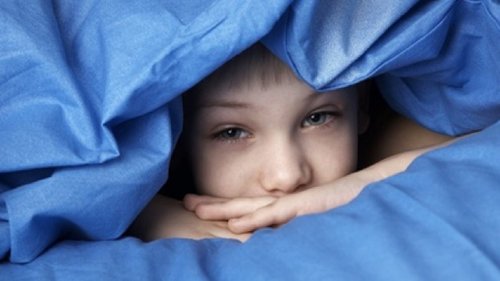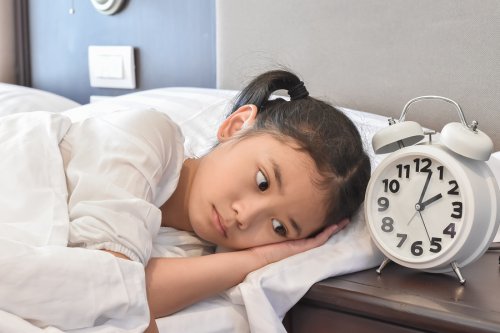The Most Common Sleep Disorders in Children

It’s important for parents to know how to detect the most common sleep disorders in children, as well as understand what causes them.
Sleep is extremely important for children, as it promotes growth and healthy development. It’s important to avoid anything that might affect this significant aspect of their lives.
When it comes to their children, parents often worry about the slightest sign of discomfort. They provide them with a proper diet, activities, and medical care. This also extends to ensuring their children get enough rest, and don’t have any sleep-related problems.
That’s why it’s important to be aware of the most common sleep disorders in children.
How to know if your child has a sleep disorder
The most common sleep disorders in children are problems that are directly or indirectly related to rest. Some of the most frequent are:
- Insomnia: when a child cannot sleep.
- Narcolepsy: the child gets tired during the day, or stays asleep for long periods of time.
- Strange behavior during sleep: sleepwalking, sleep apnea, REM sleep disorders, nightmares, night terrors, and others.
- Poor sleep habits: incorrect biological phases, as well as poorly acquired behaviors.
“Sleepwalking is a very common sleep disorder and can get better with time, without the need for treatment.”
Medical causes of sleep disorders in children
Other common sleep disorders in children are linked to a medical condition. The most frequently observed are:
- Allergies: these interrupt the child’s normal sleep patterns and lead to fitful sleep.
- Pains: strong discomfort can prevent a good night’s sleep.
- Enuresis: this is urinary incontinence during sleep. We recommend seeing a doctor if the child doesn’t have control over his or her bladder by the age of five. This can be associated with a disease like diabetes.
- Illnesses: headaches, asthma, diabetes mellitus, acid reflux, epileptic episodes, or long-term illnesses, among other conditions, can disturb a child’s sleep.
- Medications: depending on their chemical makeup, these can affect a child’s sleep.

How many hours of sleep do children need?
The amount of sleep needed depends on the child’s age. Newborns need more sleep: about 16 hours a day. In addition, they wake up every three hours to feed and have their diapers changed.
Then, after three months, they begin to sleep throughout the night, but they still need 15 hours of sleep. From six months to one year of age, they’ll sleep between 12 and 16 hours, naps included.
Later, between one and two years of age, children will need 11 to 14 hours of sleep, naps included. Children aged three to five need between 10 and 13 hours (also with naps).
Finally, from six years of age to the beginning of adolescence, they need between eight and 12 hours of sleep.
How to prevent the most common sleep disorders in children
There are things you can do to help avoid the most common sleep disorders in children. These are applicable from the lactation stage to preadolescence, and include:
- Don’t accustom children to depending on something to sleep. Examples include a bottle, or pacifier. These produce a bad habit in children, who cannot fall asleep without this element.
- Create a pleasant sleep environment. At night, parents should project confidence so the child is calm at bedtime.
- Accustom the child to sleeping alone. When sleeping with parents, the child can wake up. For this reason, it’s a habit that needs to be eliminated at an early age.

- Help your child establish a daily sleeping routine. Examples include a small snack, brushing teeth, putting on pyjamas, reading a story. You can also turn on a bedside lamp.
- Set a fixed bedtime.
- Try to encourage the child to fall asleep on his or her own.
- Avoid hyperactive behavior before sleep. This includes sports, video games, and watching TV.
What to do in the event of a sleep disorder
Some recommended measures include: forbidding long naps, serving foods that promote sleep, and avoiding foods that contain sugar and caffeine. You should also communicate a sense of security. Finally, avoid excess fluids that will wake the child up at night.
It’s vitally important that your child get proper rest according to their particular stage of development. All of this should take place in a calm setting under optimal conditions, which will help the child acquire healthy sleep habits.
Of course, if the cause appears to be medical in nature, you should see a pediatrician.
All cited sources were thoroughly reviewed by our team to ensure their quality, reliability, currency, and validity. The bibliography of this article was considered reliable and of academic or scientific accuracy.
- Consejo de Salubridad General, & Gobierno Federal. (2010). Diagnóstico y Tratamiento de los Trastornos del Sueño. Secretaría de Salud de México.
- Covertini, G., Krupitzky, S., Tripodi, M. R., & Carusso, L. (2003). Trastornos del sueño en niños sanos. Arch.Argent.Pediatr.
- Owens, J. A., Spirito, A., McGuinn, M., & Nobile, C. (2000). Sleep habits and sleep disturbance in elementary school-aged children. Journal of Developmental and Behavioral Pediatrics. https://doi.org/10.1097/00004703-200002000-00005
- Pedreira JL, Martín-Alvarez L. (2001). Trastornos del sueño en la infancia. Rev Psiquiatr Psicol Niño Adol 2001; 3(1):1-15
- Tripuraneni, M., Paruthi, S., Armbrecht, E. S., & Mitchell, R. B. (2013). Obstructive sleep apnea in children. Laryngoscope. https://doi.org/10.1002/lary.23844
This text is provided for informational purposes only and does not replace consultation with a professional. If in doubt, consult your specialist.
